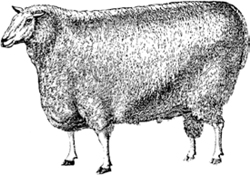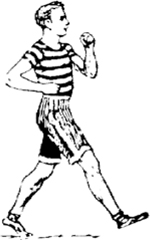Now I Know More (24 page)
Authors: Dan Lewis

When construction of the Providence Place Mall began in the late 1990s, an artist named Michael Townsend, then in his late twenties, lived in the area. According to
Salon
, he wasn't a big fan of the project, seeing it as a taxpayer-funded boondoggle that would change the character and skyline of the neighborhood. In recounting his project a decade later, he'd assert that, during construction, he noticed a sizable region within the confines of the parking garage that was destined to be underused. About five years later, that space would spark an idea.
In 2003, Providence Place began running ads as part of the mall's Christmas shopping season marketing push. One of those ads, in Townsend's words, “featured an enthusiastic female voice talking about how great it would be if you (we) could live at the mall. The central theme of the ad was that the mall not only provided a rich shopping experience but also had all the things that one would need to survive and lead a healthy life.” Being a self-described artist, he decided to put that assertion to the test. Over the next few months, he gained access to the spaceâ750 square feetâand converted it into a small apartment.
Townsend would spend up to three weeks at a time living in the apartment, spending those days documenting life as a denizen of the mall. When he wasn't living thereâhe wasn't homeless, and spent most of the time in a legitimate apartment in a real apartment buildingâother artists with whom he was friendly took up temporary residence in his secret space. Over the course of the nearly four years of the apartment's existence, a half-dozen or so artists rotated through the space.
All this came to an end after a lightweight sting operation in 2007. Mall security found out about the “dwelling” and, working with Providence police, set up a sting to catch Townsend leaving his unique vacation home. The work Townsend and company had done, to that date, was impressive. While it lacked running water (residents had to use mall bathrooms, and let's just not think about how they bathed), it was otherwise well stocked. The
Boston Globe
reported that the apartment contained “a sectional sofa and love seat, coffee and breakfast tables, chairs, lamps, rugs, paintings, a hutch filled with china, a waffle iron, TV and Sony PlayStation 2.” Ironically, the PlayStation wasn't there when Townsend was finally caught; someone had broken into the apartment and stolen it.
The
thief
who ripped off the PlayStation was never caught. Townsend, for his
crime
, was given probation.
In 2007, having an unauthorized apartment in Providence, Rhode Island, was clearly illegal. But incrediblyâand perhaps accidentallyâprostitution was not. While revising the state's legal code in 1980, legislators removed the section dealing with prostitution itself while retaining those parts dealing with on-street solicitation, running a brothel, etc. In doing so, they made the act of buying and selling sexual services legal within the state's borders. Some politicians claim that the deletion was an error, but the law wasn't changed back until 2009.

HOW ONE OF AMERICA'S LARGEST MALLS AVOIDS SCARY UTILITY BILLS
The Mall of America is located in Bloomington, Minnesota, just a few miles outside of Minneapolis/St. Paul. It is enormous. Beyond the nearly 3 million square feet of retail space, the Mall of America is host to Nickelodeon Universe, the largest indoor theme park in the country; the Sea Life Minnesota Aquarium; a mini-golf course; a wedding chapel; and other attractions typically reserved for vacation destinations. At a massive 4.2 million square feet, it's the largest mall in the United States. (The King of Prussia Mall in Pennsylvania has slightly more square footage dedicated to stores than does the Mall of America, but the latter has more total area.) For residents of the Bloomington area, the mall is also a respite from often-harsh weatherâfrom December through February, for example, the average high temperature is below freezing, and residents are regularly greeted with snow.
Yet despite its size and location, the mall's heating bills are low. As in, almost zero.
Construction for the Mall of America began in the summer of 1989 at the site of Metropolitan Stadium, a then-retired baseball and football stadium, which was the home of the Minnesota Twins and Vikings. When constructing the complex, the owners and developers decided that heating the common spaces, especially in the cold winters (nearby St. Paul averages about fifty inches of snow each year) required special attention. Instead of installing a massive central heating system, the mall's owners decided to go green, and, hopefully, save a lot of money in the process.
The mall has more than 1.2 miles of skylights, each bringing in a little bit of sunshine and warming the corridors that connect shops to one another. Then there's the excess heat from all the things being used throughout the mallâescalators, lights, and the roller coaster (yes, the mall has a roller coaster)âwhich helps keep the mall toasty even during the winter. Most important are the shoppers, tourists, and employees themselvesâtheir body heat means that you'll rarely find a day where the internal temperature of the mall falls below 70 degrees Fahrenheit.
Some stores still have their own heating systems, and many of the entranceways to the mall have heaters as well, but for all the common areas, heat is abundant, thanks to the mall's design and inhabitants. In fact, it may be
too
abundantâat times, all this free heat makes the mall overly warm. It's not uncommon for the air conditioning to be on even during the winter, as particularly busy days may lead to uncomfortably warm conditions inside.
You'll not find a lot of air conditioning in Amish communities, whose people are famous for eschewing what most of us would consider modern conveniences. However, among some Ohio-based Amish, solar panels are so common that, as of 2007, you'd find more in use, per-capita, than among any other community in the state. That's because contrary to popular belief, the Amish aren't against using electricity. Rather, according to
Wired
, they “rejected the enticements of the public power grid, deciding they did not want to be too directly linked to, or dependent on, the outside world.” Solar panels, to a large degree, come without those dependencies.

HOW SHEEP REVOLUTIONIZED ULTRA-LONG-DISTANCE RUNNING
The Westfield Group owns and operates shopping malls throughout much of the English-speaking world. Two of those malls are in Australia (where Westfield is headquartered) and are situated about 544 miles from one anotherâthere's the Westfield Parramatta in Sydney and the Westfield Doncaster in Melbourne. In 1983, those malls were Westfield's two largest in that nation. Perhaps as a publicity stunt, their parent company organized a race between the two sites. The Westfield Sydney-to-Melbourne Ultramarathon started in late April. As one would expect, most of the entrants were young but seasoned long- and ultra-long-distance runners. Within the circles of those who follow such things, they were household names.
Five days, fifteen hours, and four minutes after the runners took off, the winner crossed the finish line. His name was Cliff Young. He was a potato farmer who ran funny, had fallen miles behind the competition on the first day, and, oh yeah, was sixty-one years old.
He won by ten hours.
To be fair, Young had been running all of his life; he just hadn't been doing so competitively. Even at age sixty, he was working and living on the family farm on which he grew up. Potatoes were the major crop there, but the 2,000-acre farm was also home to a 2,000-strong herd of sheep. As he explained in various media reports, growing up, his family couldn't afford tractors or horses. When storms came to the region, rounding up the sheep therefore became a major ordealâand Young had to do it himself, by foot. He claimed to run around, herding sheep, for two or three days straightâoften while wearing rainboots. Endurance like that, he correctly believed, gave him a huge advantage over the other runners.
But when the race came, it didn't start off well. Young didn't run with long strides like most of the other runners, instead shuffling his feet over very short distances, a movement that was more of a waddle than a step. Most of the runners left him in the dust. By the time the race was eighteen hours old and racers went to get their typical six hours of sleep, Young was so far off the lead that he was at best a curiosity and at worst a punch line.
Six hours later, the other runners woke up to find that Young hadn't stopped to sleep and was now well in the lead.
It's unclear how much he slept over the five-plus-day runâby some reports, Young didn't sleep at allâbut however much it was, it wasn't much. Young finished well in first place because he spent a lot more time running (and less time sleeping) than his competition. He attributed his endurance to his experience chasing down the sheep and, counterintuitively to those watching and participating in the race, his funky-looking running style.
And it turns out that may actually have mattered. Young's running style, now called the “Young Shuffle,” is commonly believed to require less energy than other forms of running, making it an attractive option for ultramarathoners, including a few subsequent winners of the Sydney-to-Melbourne race in years after Young's win.
The world record for most time awake without sleep? 264 hours, according to
Scientific American
. The record was set in 1965 by a seventeen-year-old who stayed awake for roughly eleven days as part of a science fair experiment.

THE MOST PEDESTRIAN OF SPORTS
Walking is a pretty fundamental method of locomotion for peopleâalmost all of us can do it and do it often. It is also something we take for granted, hardly giving it a second thought. Why would we? While walking may separate us from many other animals, it's so commonplace that we don't think of it as anything special.
Compare it to the requirements of today's great athletic competitions. Baseball, basketball, football, tennis, and soccer players run. If you play ice hockey, you skate. Gymnasts seem to fly. There are cyclists, swimmers, and even people who dance while trying to punch each other unconscious, all in furtherance of athletic accolades and often in front of cheering crowds. In each of these sports, there are heroes, from Babe Ruth and Michael Jordan to Michael Phelps and Muhammad Ali.
No one ever earned fame for winning a walking competition. Except for a guy named Edward Payson Weston, that is.
Weston was born in 1839 in Rhode Island, and in 1860 he made a bet that would change his life forever (and the world of sports temporarily). He wagered that Abraham Lincoln would lose the upcoming presidential election, agreeing to attend Lincoln's inauguration if he lost the bet. The wrinkle was that Weston would have to walk to Washington for the event, which was particularly problematic because Weston lived in Boston, nearly 500 miles away.